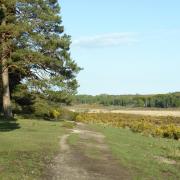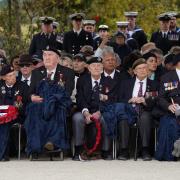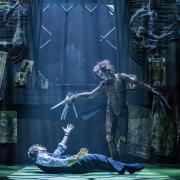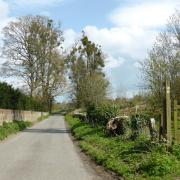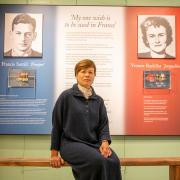For forty years artist Frank Jennings has made a living from ‘deceptive receptacles’, writer Olivia Greenway fell in love with his work at his Sheet studio

Frank Jennings’ artist’s studio is the embodiment of peace and quiet, positioned next to his eighteenth century cottage, in the sleepy village of Sheet, near Petersfield. From the doorway, a winding path leads a short way over a grassy sloping lawn to the River Rother at the bottom of the secluded garden. We sit under an old willow, watching the watery world go by, an old millstone as our table. Here over a cup of tea, Jennings tells me how, forty years ago this month, he made his first ‘assemblage’ or ‘deceptive receptacle’ as he prefers to call his handmade box-like artwork. It was entitled ‘Light-headed’ and featured a self-portrait in latex, resembling a doll’s head and positioned inside a light bulb. “I like to inject a sense of humour if I can,” he grins, in his gentle, unassuming way, a faint Yorkshire burr just discernible.
He always knew his first love was art, >> winning an art competition at age eight, but his father had other ideas. “He was the old-fashioned sort and wanted me to have a trade. So I did a four year engineering apprenticeship,” he explains. “After that, I decided to do a foundation course at Bradford College of Art.” His father was not impressed, so Jennings left his Bingley home. Years later, when he became successful, he admits, “My father was very proud of me, eventually.”
After completing a fine art degree, followed by a year teacher training at Leeds University, he was offered an assistantship by Canada’s most famous sculptor, Uyllse Comtois, so took himself off to Montreal for two years. Back in the United Kingdom, it was now the early eighties and work was becoming hard to find.
“Several colleges were amalgamated near me and jobs just disappeared.” Jennings decided to “Get on my bike”, as Norman Tebbit had famously suggested in the aftermath of the 1981 riots and applied for jobs countrywide, finally securing one at South Downs College in 1983. He worked his way up to Head of Curriculum for art, design and media, retiring in 2008.
We finish our tea and he shows me his studio, where he has worked for the past thirty years. Inside, it is bathed in sunlight from the large windows, a skylight also making the most of the natural daylight.
Around the walls are racks upon racks of wooden drawers. Jennings reads my mind: “There are over a hundred drawers in here.” I slide several open like a child in a sweetshop and find seashells, tiny plastic farm animals and metal toy soldiers; in yet another, small pieces of driftwood. “I’m a collector; I find objects fascinating,” he explains. “I like the idea of putting everyday mundane objects together and organising them. The objects retain their own identity but at the same time suggest another concept.”
In his work ‘The Day the Midnight Milk Race turned Sour’, the depicted cyclist normally seen raising his arms in joy at winning a race is being held up at gunpoint. In another ‘The Student and the Apprentice’s First Dance’, a cowboy figure reaching for his gun, is seemingly attempting to dance. ‘The Usual Suspects’ features a police horse and a pantomime horse watching an identity parade of a cowboy suspect, with caricatured bandy legs, a magnet, a wishbone and a bent nail. ‘From the Wardrobe of a Fastidious Dutchman’ has a shoetree inside a wooden clog and ‘The Boyhood of Brunel’ has the usual child’s folded paper boat replaced with a metal one with iron chain. ‘The Narcissus Brothers in Transit’ sees two men pushing a barrow with a double-sided mirror, such as one used to find in budgerigar cages, in the middle. What made him decide to put objects in a box, I wondered? “Oh it’s not a new idea. Joseph Cornell was a famous American assemblagist. But I admit to being an admirer of fellow Yorkshire man Edward Wadsworth and the American H C Westermann.”
Jennings has a large stockpile of second hand wood to make the assemblages. The boxes themselves are carefully crafted and get as much, if not more attention as the contents.
“I like hardwood such as birch and oak, but anything with a strong grain appeals.”
Some assemblages use up to fifty pieces of wood that he painstakingly cuts to shape. The assemblages have a glass front and can be accessed from the rear for final cleaning.
“Once the work it is finished, I like to tidy it up inside, so it is perfect and ready to hang, like a painting.”
Looking around the studio at the drawers containing hundreds of objects, I wonder where he finds his raw materials. When I am baking a cake, I go to a supermarket for ingredients, but to Jennings ‘ingredients’ are what he calls his stock, “I go to car boot sales, junk shops, auctions and antique shops. Whereas most people are looking for something valuable that someone has missed, I’m looking for ordinary old objects that most people are not interested in.”
Like most artists, Jennings feels a strong need to share his work, “If you make things, those things should be seen,” which could explain the 100 exhibitions where he has shown his work both locally in Petersfield and Chichester; and in London. The next exhibition that he is working on now is in October, in his boyhood county of Yorkshire at the Zillah Bell Gallery, Thirsk and runs until the 9th November.
In London, he has shown regularly since 1995 at the Discerning Eye, in The Mall Galleries. Curators, art critics and collectors form a panel to select the anonymous works. At the time of going to press, Jennings should know if his work has been chosen again this year for the show in November. He has also just heard a local gallery may be exhibiting his work.
I ask if anyone famous has bought his assemblages. Jennings smiles enigmatically but won’t be drawn.
“There is a titled lady and one of my fans has six pieces, that I’m told hang next to a Gainsborough.”
He sells locally too, to fellow artists and collectors. There is a lively interest in art in the Petersfield area, possibly because it is still surrounded by beautiful inspirational countryside and also was the home of Flora Twort, the accomplished Slade artist who lived and painted in the town from 1914 until her death in 1985. Jennings has undertaken commissions, but he prefers to devise his own ideas and to sell through exhibitions. Occasionally he will produce a similar work, to save someone being disappointed if an assemblage is popular, but no two pieces are ever the same.
He doesn’t know exactly how many assemblages he has made, but estimates it to be around 400. Prices start at £350 and increase to £2,500. The smallest piece can take three days to make but most take much longer, the most complicated involving three months’ work.
Mallard ducks quack excitedly on the river and draw us out of the studio. Perhaps he will come up with an idea as he takes a break at the millstone table.
Meanwhile, I am left wondering who likes me enough to buy me one of his pieces.
***
Find out more about our artist of the month at www.frankjennings.net




